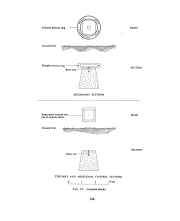Block
Introduction
The History of the Retriangulation of Great Britain 1935-1962, p225, 7.032 states: "From 1941 to 1949 ground stations for minor triangulation and Town Control were also marked by standard pillars. As a result, by 1948 there were too many pillars in and around the larger towns, and it was decided to introduce a simple less obtrusive, and incidentally less expensive, type of ground mark consisting of a concrete block cast in situ." Note however that many of the blocks in the OSGB36 list predate this. For example, those in Secondary Computing Block TA43 were computed in 1939.
Block
A 'Block' is a concrete block approx 1 cu ft in dimension emplaced such that the top surface is at ground level. A bolt, with head diameters measured to date between 3/4" and 2 3/8", is fixed at the centre of the upper face of the block. Over time surface soil, vegetation, etc can build up resulting in the block being several inches below ground level. Quite often, a benchmark is cut into the block's upper surface, sometimes into the bolt. A block can be destroyed when a field is ploughed or a hedge is grubbed-out. But occasionally it may be moved out of the way by the farmer, for example at Summer House.
Buried Block
In appearance, Blocks and Buried Blocks are identical. 'Buried Blocks' were designed to be buried below ground level (0.6m is a typical depth; the deepest located so far is Burton in Lincolnshire at 0.9m), however, they can be found much closer to the surface. Finding Buried Blocks, especially where the ground has been undisturbed for several decades, can require persistence. In some cases, a slight depression in the turf may be a clue. A tool known as a searcher was used by the OS to help relocate the trig mark. Metal detectors were also used. At some point the OS experimented with introducing a ferrous substance (iron filings?) into the concrete mix of some buried blocks[Citation needed] to aid in locating these trigs. Apparently it wasn't very successful. A different relocation technique was to cover the block with a metal sheet, for example Long Hill [1] Another was to embed scrap metal into the block [2], for example Sniperley Farm, Nashes Farm and Tir Phil.
As of 2024, it became possible to use a high-quality GPS receiver such as the Trimble DA2. In conjunction with a commercial subscription service, this applies a positional correction giving sub-metre accuracy. This has proved very successful in locating buried blocks.
An emplacement ring, known to trig baggers as a Concrete Ring, was sometimes installed above a buried block. It could assist in locating a trig mark, but is not in itself a mark. A detector plate, otherwise referred to as a Covered bolt, served a similar purpose.
Surface Block
The term 'Surface Block' is derived from the OS Passive Stations database. A number of OSGB36 Blocks were reused as Passive Stations and some new Blocks were constructed. Apart from Ferrule Blocks, Surface Blocks are physically indistinguishable from Blocks.
A Buried Block, approx 1ft deep
Example of a block with benchmark
References
- ↑ OS sketch for Long Hill
- ↑ email from Ian Wilson to the Trigonomy mailing list, 24/09/2013






